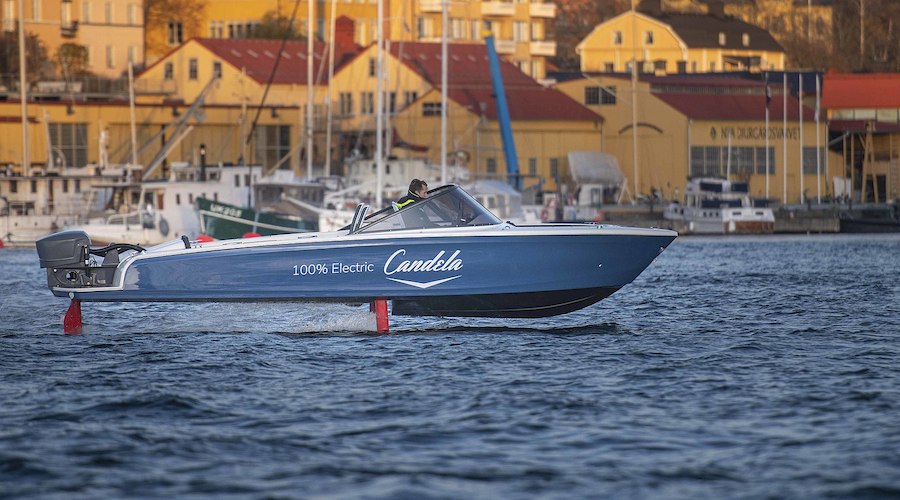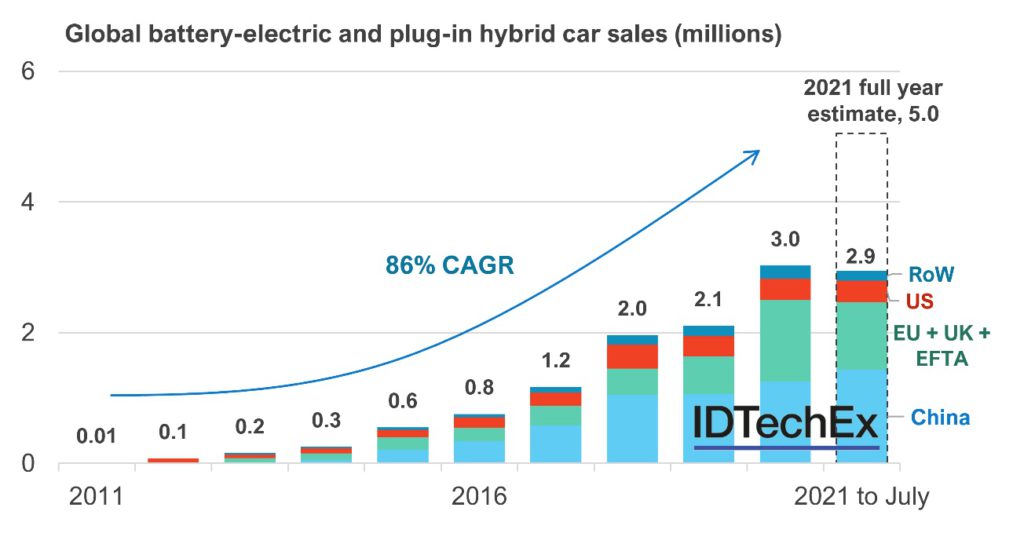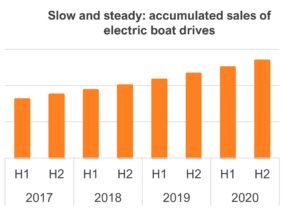
In a recent analysis, IDTechEx acknowledged that, back in 2011, its ‘bullish’ forecasts of 1.5 million new EVs hitting the roads by 2021 were a massive underestimation as, ‘once the future arrived,’ sales of electric vehicles are on track to surpass five million units this year — counting only passenger cars.
“If they do, it will mean an astonishing growth rate of ~86% CAGR since 2011,” the report reads. “Perhaps, more importantly, electric vehicle markets are proving they are robust: they can grow despite a global pandemic shutting down factories and are not so much unstoppable as inevitable.”
IDTechEx data show that for the past decade, electric car markets have been continuously growing with 2019 being the only exceptional year as sales were dampened by a policy transition in China and lacklustre governmental support in the United States.
Two years and a pandemic later, EV sales are growing in all three top auto markets: China, the US, and Europe. The latter has been particularly important because new emission targets of 95g of CO2 per kilometre force automakers to push for EV sales, which are also supported by commitments to reach 100% electrification by 2025 in the case of Norway, and by 2030 for the UK.

In the US, sales are also being promoted by president Joe Biden’s $174 million commitment for supporting electric vehicle uptake, from charging infrastructure to topping up the federal tax credit, and by his proposed new target of reaching 50% electrification by 2030.
Finally, in China, purchase subsidy schemes around for over half a decade are being extended to help break in the new energy vehicle double credit schemes moving forward.
“Overall, the net effect is electric vehicle policy from around the world is pushing electric vehicles into the mainstream this decade, creating tremendous opportunities for those operating in the electric vehicle supply chain,” the review states.
“Critically, while Tesla still leads market share in Europe and the US, incumbent automakers have been increasing their skin in the game. This year alone there have been over 20 announcements related to increasing targets and electrification plans.”
According to the market analyst, truck original equipment manufacturers (OEMs) are under growing pressure to reduce emissions, as one of the largest on-road contributors to them. This is why developments at Daimler, Volvo, and Scania continue to move on at pace, while the launch of Tesla’s semi is expected in 2022.
Yet, there are still concerns regarding the feasibility of deploying battery-electric trucks, especially in long-haul applications, as the energy density of current lithium-ion batteries is a limiting factor.
But IDTechEx’s review shows that the density challenge is promoting the development of fuel cell technologies that offer OEMs an avenue to a greater range in heavy-duty applications, whilst — in some scenarios — still achieving low or zero emissions.
Fuel cells can provide the primary power source to drive the electric traction motors, or alternatively, act as a range extender that charges the traction battery during operation.
“But fuel cells are not a silver bullet for heavy-duty transport: significant hurdles need to be overcome for them to become viable,” the report reads.
“Aside from the typical technical and economic challenges that accompany any new automotive technology, critical to the success of fuel cell vehicles will be the rollout of hydrogen refuelling infrastructure and the production of cheap ‘green’ hydrogen – low carbon hydrogen made from renewable electricity and water.”
As the conceptualization, design and making of heavy-duty clean energy trucks move forward, analyses on the EV market ought to take into account that electrification is also taking place on the waterways with electric boats and ships.
According to IDTechEx, this market is driven by technological innovations and falling battery costs rather than policy.
As an example, the firm highlights the case of Swedish start-up Candela who made available a new electric hydro-foiling boat in August and has plans to release a small water bus and passenger ferry later, initially in Stockholm.

“A hydrofoil is an ‘underwater wing’ which generates lift when a vessel moves. At speed, the vessel is raised out of the water, which greatly reduces friction. The innovation has more than halved the battery size required to travel 50 nautical miles for electric vessels of a similar size – 45kWh, instead of 120kWh,” the document states.
“The release of the new model – the C8 – made improvements to the design to help with mass production, amongst other things. The company matched its three-year order book from the previous C7 model in one month.”
Besides Candela, the report brings attention to the work of Torqeedo, the market-leading supplier of electric outboard and inboard drives for leisure boats and small fishing boats, whose sales have surpassed 100,000 electric boat drive units in a milestone that is considered to signal steady progress for the industry.
IDTechEx’s report does not make the case for electric airplanes but for electric air taxis, as recent advances in battery technology and electric motors have facilitated the design of electric vertical take-off and landing (eVTOL) aircraft, with distributed electric propulsion architectures, that can alleviate many of the issues that have prevented helicopter travel from becoming more mainstream.
The analyst believes that the closest to market is the Joby Aviation S4 Air Taxi. The company has over 10-years of experience in eVTOL design and 1000+ test flights in a full-scale production prototype, beginning FAA certification in 2018.
“However, the activity in this space should be tempered by the fact that even Joby, with all their experience, say they have ‘several years’ more testing before approval,” the review states.
“While this market is coming, IDTechEx believes it will be at least a decade before we see any widespread deployment of air taxis. One of the major barriers is regulation, rather than technology. From IDTechEx’s sample of the most promising eVTOL companies, timelines are highly dependent on the final flight certification process and regulation around flight operations in each geographical market.”